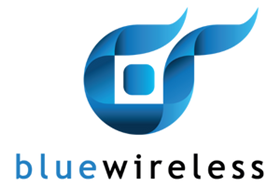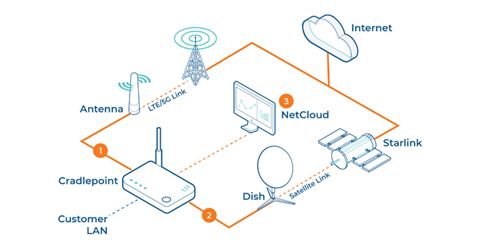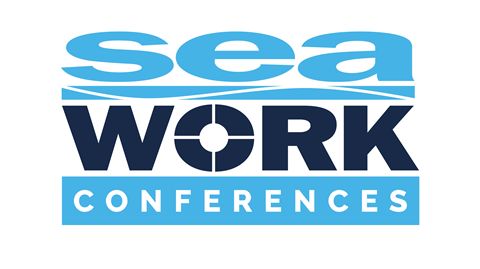While we tend to focus our attention on LTE/5G, wireless connectivity isn’t limited to cellular networks. Besides terrestrial, satellites are attracting WAN Managers’ attention and becoming a common topic in our daily conversations with customers, – more specifically, Starlink.

Starlink is a constellation of LEO (Low Earth Orbit) satellites providing internet access to a growing part of the world, including underserved regions like rural Africa. There are approximately 5,000 of them currently circling the globe, with plans for an eventual 42,000: a peek at Starlink’s satellite coverage will show how busy it’s been. And while it’s still developing, we cannot deny its potential to offer businesses and individuals some serious advantages.
But where will it work best, how will it interoperate with other connectivity options, and is there anything it’s not suitable for? In this article, we’ll answer your questions – as we go where few wireless connectivity providers have gone before.
An evolving technology: ready for business?
Satellite internet was invented some time back – not quite a long time ago in a galaxy far, far away, but close, with Hughesnet and Viasat offering plans to both homes and businesses, and old hands Inmarsat serving ships and airlines for years. However, there are several types of satellite broadband.
For these three, the “birds in the air” are GEO satellites: Geostationary Earth Orbit, 35,785km above the equator. (The number’s important: at that height, the satellite stays in the same place relative to our planet’s surface, meaning a single satellite can cover a large area with no need for earthbound dishes to track a moving target.)
Starlink’s birds occupy a lower orbit, 550km – and move around, meaning customers’ antennas must cover more of the sky to effectively “see” them. Although, there are so many satellites that coverage is (mostly) assured, and getting better with time. Also, as they are positioned closer to the earth, they offer lower latency than traditional satellites, making them a more attractive alternative for modern enterprise use.
That said, bandwidth can differ dramatically depending on your location, environment, and time of day – which is why it’s important to understand your own situation and the performance and limitations of the services you’re incorporating into your network – whether these are cellular, satellite or wired broadband.
The cost case: optimism about affordability
Satellite operators don’t experience the intense competition you see with terrestrial cellular networks: inventory is limited and often oversubscribed, and with fewer players in the sector, there’s not as much pressure to slash prices. And there isn’t yet a vast customer base to amortise costs, unlike LTE/5G.
So, business-class broadband from satellite providers, including Starlink, can look expensive compared to the average terrestrial plan - now. And while this may change eventually, it is recommended to evaluate your budgets, use case, and broadband technologies at your location. In many parts of the world, 4G and 5G are so good there’s little need for a satellite option. For other use cases, the cost/performance balance is worth the investment.

Broadband speeds: comparable to 5G … or not?
While LEO is notably faster, and with much lower latency than traditional satellite broadband, in good conditions, Starlink offers between 50 and 250Mbps. No slouch – but remember that wireless “pipe” is shared between a growing volume of users, creating speedbumps in the sky at busy times. And while Starlink performs well in bad weather – in the rain – there’s still potential for noticeable degradation (rain fade) to be expected in a downpour.
LTE/5G can hit a blistering 2Gbps, in theory. While that max is rarely seen in practice, in pure performance, terrestrial wireless beats orbital across lots of deployments. Again, this may change – but as above, it’ll likely depend on market adoption, not just technology.
But isn’t this the future of, well, everything?
The space industry contains some of the most exotic engineering ever created, and cutting-edge tech excites many people. So, we’re often asked by customers if they should bother with a tailored broadband solution that includes cellular, since “satellite is the future”.
Well, it is an option. But, as with any other buying decision, it’s all about what the services can offer the customer: how it can help their businesses, solve their business problems, and enable their growth. It’s about finding the right solution for the right problem.
Currently, broadband networks, right here on Earth, have huge and increasing capacity and coverage and can answer countless use cases from nearshore shipping and offshore aquaculture to centre-city business districts and pop-up marketing events in the park. But, while our origin story is in cellular networks, we’re big fans of emerging technologies and how they can support our customers to improve connectivity. So, if satellite can help you live long and prosper, we’ll support you on your journey.

Avoiding complications: local equipment integration
And so, to the Ultimate Question: will Starlink add complexity to your broadband setup? More equipment means more maintenance, higher costs, and greater hassle. Or does it?
Of course, a satellite option means new hardware, like Starlink’s dish – but in the field, we expect complete assimilation to be a straightforward trek. Remember, the critical factor here is to ensure always-on, always-available broadband for your business. Which means you can use satellite connectivity in various ways.
With Cradlepoint routers (our longtime business partner), your solution can combine Starlink and LTE/5G to provide broadband capacity, and then switch between technologies to give the best service at all times. On a ship, for example, this could mean LTE/5G in dock and satellite when under sail.
It also makes a great backup and failover option: if a disaster befalls a critical LTE/5G mast, your employees can continue working without any downtime, not even realising their data is moving across the cold, infinite reaches of space.
Even in ultra-critical applications scenarios, Starlink, LTE/5G, and wired broadband can come together effectively. A backup to the backup of your backup… it doesn’t get safer than that.
Wrapping up: Satellite technology is there for you when it’s right for you
We hope the above “blue sky thinking” has addressed some of your questions about your broadband options –for the near future or your long-term planning.
Nobody knows what the years ahead hold – but when satellite fits your use case, we’ll make sure to recommend it and help you along that journey.
So, talk to our experts today and let’s explore the universe of possibilities.











